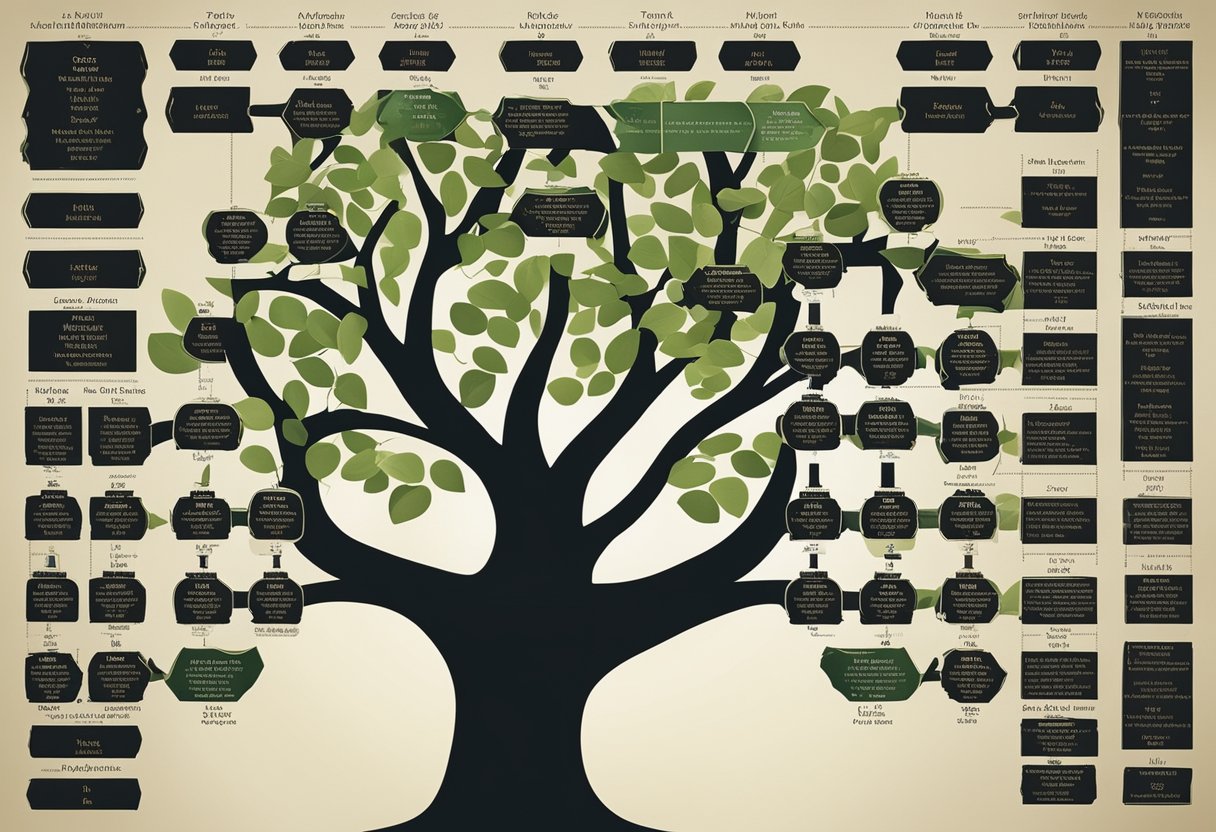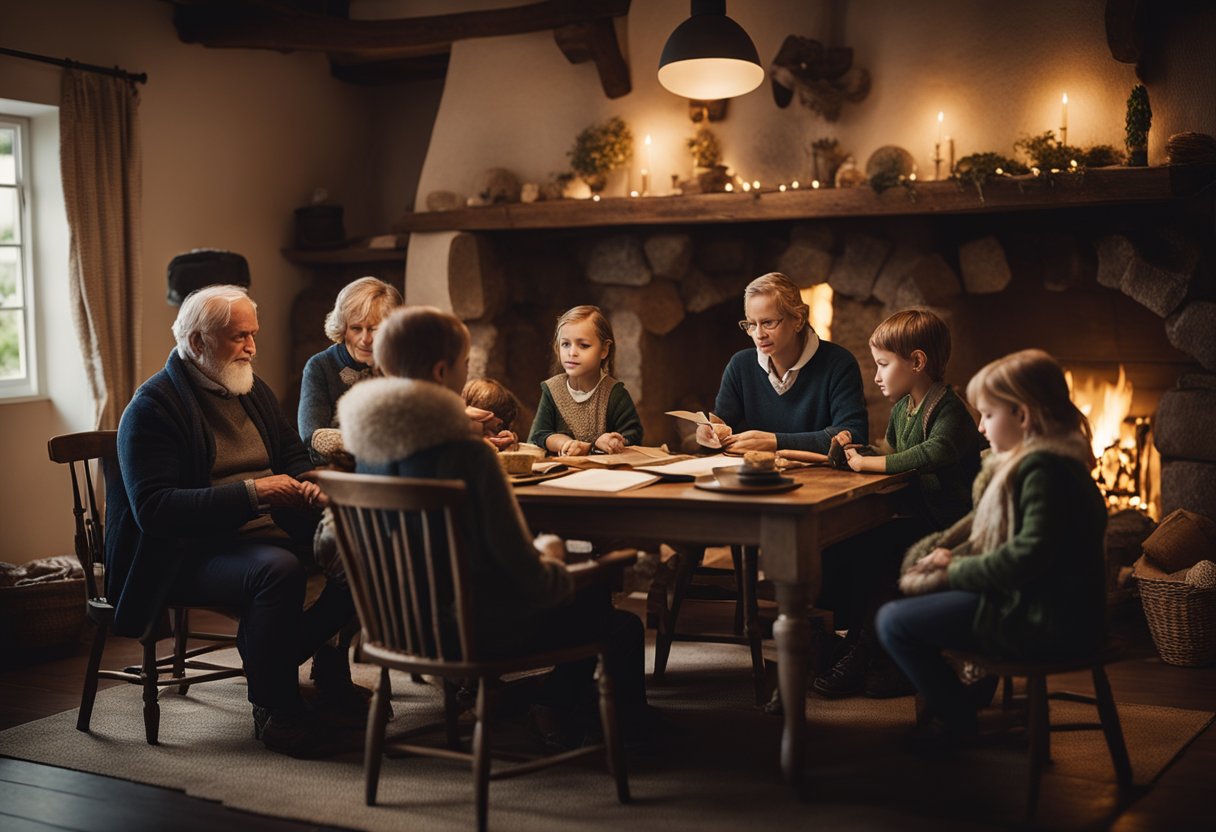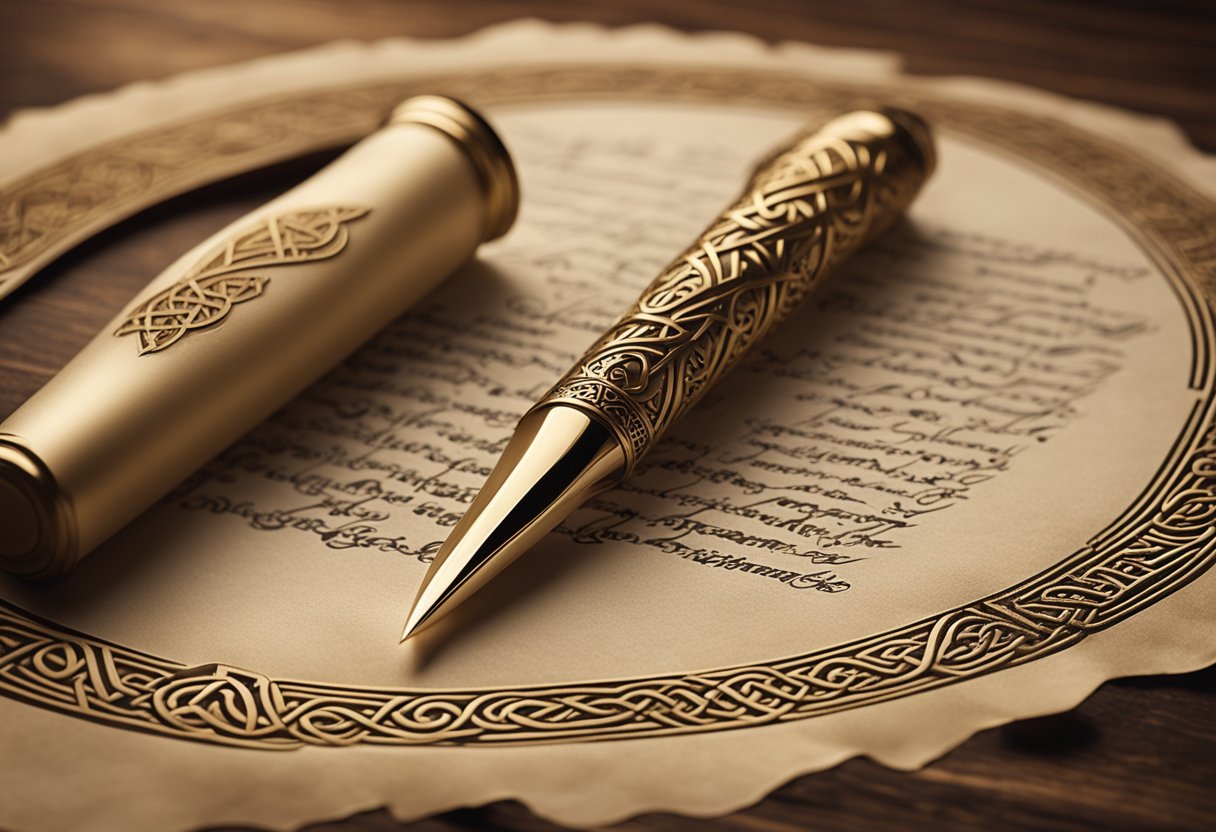Traditional Irish Naming Customs: A Guide to Gaelic Heritage Names

Updated On: March 13, 2024 by Eman Sameh
Traditional Irish naming customs offer a fascinating window into the culture and heritage of Ireland. Rooted in a deep sense of family and continuity, these customs have dictated the naming of children for generations. They reflect the importance of ancestry and respect for familial lineage, with patterns and practices that have been passed down through the ages. Understanding these customs can provide valuable insights into Irish genealogy and the social structure of the past.

Historically, the methodology behind choosing names within Irish families often followed a set pattern, prioritising the honouring of grandparents and other relatives. This systematic approach not only strengthened family ties but also served as a means of preserving one’s heritage. The structure of Irish names themselves, encompassing given names and surnames, has its own unique set of conventions. These names were, and often still are, laden with meanings and connections to Irish mythology and history.
Historical Context of Irish Naming Customs
Naming customs provide invaluable insights into tracing the lineage of Irish families. They reflect religious adherence and deep-rooted linguistic traditions.
The Role of Religion and Family
Religion has historically played a central role in Ireland, influencing many aspects of daily life, including the naming of children. Baptismal traditions often dictated that children be given names of saints, reinforcing the family’s faith and creating a sense of continuity with past generations. This religious practice ensured that many Irish names connected to the Church, often reflecting the family’s hope for their child’s virtuous life.
Influence of Gaelic and Patronymic Traditions
The Gaelic language has left a profound impression on Irish naming conventions. Many traditional Gaeltacht names originate from Gaelic, with names often being adapted to English phonetics, granting us clues to our forebears. The patronymic system, in which a child’s surname is formed from the genitive case of the father’s first name prefixed with “Ó” (grandson of) or “Mac” (son of), was widely used. This system not only signified lineage but also indicated family ties and heritage, with certain names becoming synonymous with specific regions in Ireland.
Understanding Traditional Irish Naming Patterns
In exploring the traditional Irish naming patterns, it’s essential to appreciate their structured nature and historical significance, which provide a sense of continuity across generations.
Basis and Evolution Over Time
Traditional Irish naming patterns were remarkably systematic, offering insights into family ties and heritage. Historically, the first son would often be named after the father’s father, while the second son would be named after the mother’s father. Similarly, the first daughter was typically named after the mother’s mother, and the second daughter after the father’s mother. This convention ensured the perpetuation of names within the family lineage, honouring ancestors and maintaining a connection to the past.
However, these customs have seen a shift over time. As social dynamics changed and fashion in names evolved, strict adherence to this pattern became less common. Although remnants of the practice may still be found, modern naming favours a more diverse range of inspirations.
Comparison With Other Cultural Naming Practices
When we compare Irish naming conventions to those of other cultures, the contrast is often quite distinct. In some societies, names are tied to religious beliefs or chosen for their meanings. Other cultures may name children based on circumstances of birth, significant events, or desirable traits. However, the Irish method is particularly genealogical in its approach, emphasising the reinforcement of family identity through naming.
While naming patterns in Irish culture prioritised lineage, today’s global influences and the international mix of cultures have introduced a broader spectrum of names into the Irish milieu. This blend reflects a fashion for diversity and a move away from strictly traditional naming conventions — a testament to the fluid nature of cultural practices.
Structural Elements of Irish Names

Irish naming conventions are characterised by a distinct structure, integrating both historical and cultural significances. Let’s examine the traditional aspects of how given names and surnames are employed, as well as the incorporation of middle names and prefixes within Irish names.
Given Names and Surnames Explained
Given names, often referred to as first names, are personal identifiers chosen at birth. Historically, Irish given names are deeply rooted in family and religious traditions, frequently honouring saints or ancestral figures. Surnames, or family names, are inherited and typically designate lineage. Traditional Irish surnames often begin with prefixes such as ‘O” meaning ‘descendant of’, or ‘Mac’, meaning ‘son of’. These prefixes highlight the importance of heritage and genealogy within Irish culture. An example would be O’Connor, indicating descent from a forebear named Connor.
Use of Middle Names and Prefixes
Middle names in Irish culture are often used to reflect a wider family connection or honour a relative directly. Having a middle name allows the incorporation of additional family names beyond just the paternal line. In terms of prefixes, they are an integral part of many Irish surnames. The prefix ‘Fitz’ is another example, derived from the Norman influence and meaning ‘son of’, found in names such as Fitzgerald. These structural components demonstrate the layered significance of names within the Irish cultural context. Middle names can carry as much weight in family history as given and family names, often used to perpetuate the names of grandparents and other relatives.
Delineation of Family Positions in Names

In traditional Irish naming customs, specific family names carry great significance, often honouring ancestors and strengthening family identity. The naming patterns reflect the position of each child in the family hierarchy.
Name Selection for Eldest and Younger Children
For boys, the oldest son is typically named after the paternal grandfather, forging a link to the previous generation. The second son often bears the name of the maternal grandfather, while the third son is usually named after his father. Should there be a fourth son, he might be named after his father’s eldest brother, continuing the tradition of honouring close family members. As for daughters, the oldest daughter is customarily named after the maternal grandmother and the 2nd daughter after the paternal grandmother. Subsequent daughters may be named after their grandaunts or mothers.
- Eldest children:
- Oldest son: Paternal grandfather’s name
- Oldest daughter: Maternal grandmother’s name
- Younger children:
- Sons: Maternal grandfather, father, father’s eldest brother
- Daughters: Paternal grandmother, grandaunts, mother
Special Naming Conventions for Twins and Subsequent Births
Twins often receive names that are complementary or have significance within the family narrative. For instance, if they are the firstborn, they may still follow the tradition of being named after grandparents. In instances of unexpected births, such as a third daughter or third son, naming might take inspiration from more distant relatives, saints’ names, or a middle name that holds particular familial importance.
- Twins: Complementary or traditional family names
- Subsequent births:
- Sons: Names from wider family circle or saints
- Daughters: May include family names or virtues
Through these naming patterns, every child’s identity is deeply interwoven with their ancestry, providing a tangible connection to family history and the collective memory of previous generations.
The Importance of Grandparents in Irish Names
In traditional Irish naming customs, grandparents’ names hold significant weight, particularly in the naming of the earliest-born children, which showcases a profound respect for family lineage and identity.
Paternal and Maternal Lineage Impact
Paternal Grandfather: Traditionally, the firstborn son is named after the paternal grandfather, signifying the continuation of the father’s lineage. This practice honours the father’s father as a central figure in the family hierarchy and ensures the transmission of his name to subsequent generations.
Maternal Grandparents: Equally important is the role of the maternal grandparents. The firstborn daughter would often be named after the mother’s mother, a gesture of respect towards the maternal side of the family. It’s common for the second daughter to take the name of her paternal grandmother, balancing both sides of the family tree in the naming convention.
Repetition and Honoring of Grandparents
Repetition: In instances where a child, such as the third son or fourth son, was stillborn or did not survive, the name of the grandparent would typically be given to the next son, reinforcing the family’s desire to memorialise the grandparents’ names within the familial line.
Honoring: The continuing tradition encompasses not only direct grandparents but also the parents’ siblings. For instance, naming conventions might extend to the father’s oldest brother or the mother’s oldest sister, further honouring the grandparents by naming children after their children.
Through these customs, the Irish people carve a venerable connection to their heritage, intricately weaving the names of maternal and paternal grandparents into the fabric of family identity.
Cultural and Social Influences on Naming
In Irish tradition, names are more than mere labels; they reflect social status, family expectations, and historical factors that have shaped Ireland for centuries.
Naming Trends Among the Wealthy and Common Folk
Amongst the wealthy, naming often followed fashion and a desire to reflect one’s social standing. Wealthier families might select names that connote a sense of heritage and continuity of affluence. For example, names with Norman or Anglo-Irish origins might be preferred to denote class and lineage, such as those detailed on Ireland’s heritage and Viking influences.
Conversely, the common folk might more frequently choose names imbued with familial or religious significance, often honouring saints or using names passed down through generations. These might include names like Patrick or Bridget, which carry deep cultural resonance, as indicated by their prevalence in 19th-century names.
Impact of Infant Mortality on Naming
Infant mortality, a sorrowful reality for many Irish families, had a distinct impact on naming conventions. It was not uncommon for a newborn to receive the name of a deceased child, ensuring the name persisted within the family. This practice, while emotionally laden, served as a poignant remembrance and a means of keeping the child’s memory alive.
The high rates of infant mortality also influenced how names were recorded in church records, often reflecting multiple children with the same name within the same family. The careful tracking of these names provides us today with critical insight into family structures and lineages. Church records are central to understanding 19th-century Irish demographics, an era with limited census data, as elaborated upon in accounts of Irish naming norms and baptism traditions.
Records and Genealogical Research on Irish Names
When exploring genealogy, we consider various records essential in piecing together our ancestry. For those of Irish descent, census and baptismal records play a pivotal role, and overcoming challenges in tracing lineage is a common part of the journey.
Use of Census and Baptismal Records
Census records often serve as fundamental tools for establishing a family tree. Ireland’s rich genealogical tapestry can be examined through census records, albeit with some historical challenges due to the loss of many 19th-century records. However, parish registers and baptismal records become invaluable, offering insights into family connections and movements. For instance, before the 1901 and 1911 censuses, which are fully available online, we relied on surviving census fragments or transcriptions.
As genealogists, we also examine baptismal records to discover ancestors’ names, and these can often provide a link to the parish of origin. These records not only indicate religious affiliations but can also infer immigration patterns and ancestral origins.
Overcoming ‘Brick Walls’ in Ancestor Tracing
Encountering ‘brick walls’ in genealogy research can be both frustrating and common. For Irish genealogy, these barriers often arise due to missing records or common surnames and given names. To circumvent these, we meticulously analyse available documents, such as immigration lists and passenger records, which can trace an immigrant’s trail back to Ireland.
Should traditional records fail, alternative approaches, such as DNA testing, offer new means to connect with potential relatives and ancestral homelands. By combining traditional records with modern technology, we fortify our understanding of family history, paving the way to discovering our ancestry.
Irish Immigrants and Naming Adaptations

When Irish immigrants settled in new lands, they often adapted their names. These changes and the consistent patterns in their original naming customs are vital to understanding genealogy and tracing ancestry.
Changes in Names Upon Moving Abroad
Irish immigrants frequently modified their names to assimilate into their new communities or to ease pronunciation issues. For instance, names often changed spellings; “O’Neill” might have become “O’Neal” or “Neil”. Such alterations impacted genealogical research, as family lines could be harder to trace. Equally, first names were often translated into their English equivalents or completely changed to become more “local”. “Pádraig” might have turned into “Patrick”, and “Brighid” into “Bridget”.
Traceability of Immigrant Ancestors Through Names
Despite the modifications, the traditional Irish naming patterns can assist in the traceability of immigrant ancestors. The first son, named after the paternal grandfather, and the second named after the maternal grandfather, can guide genealogists when searching for lineage links, even after immigration. However, the reliability of this approach can be impacted by the degree of name adaptation by the immigrant families, resulting in some challenges in mapping out accurate ancestry records.
Popular Irish Names and Their Meanings
We delve into the etymology and significance behind traditional Irish names, highlighting their deep roots in history and cultural importance.
Common Names From Historical and Modern Perspectives
Traditionally, Irish names have been tied not only to family lineage but also to the Gaelic language and Catholic saints. Names such as Seán and Máire have longstanding popularity. In recent times, however, modern parents in Ireland might opt for names that blend traditional Irish elements with contemporary appeal.
Seán, for instance, remains a widespread choice, originating from the Gaelic version of John, meaning “God is gracious.” Máire, the Irish form of Mary, often symbolises purity and is frequently associated with the Virgin Mary, further reinforcing its historical popularity.
Etymology and Significance of Names Like ‘Murphy’ and ‘Mary’
Irish names often carry significant meanings and reflect a heritage steeped in storytelling and the natural landscape. Take ‘Murphy’ as an example, derived from two Irish words, ‘sea’ and ‘warrior, ‘ which convey the image of a sea battler.
On the other hand, ‘Mary’ (Máire in Irish), although of Hebrew origin meaning ‘wished-for child’, has been widely adopted in Ireland due to its religious connections and remains one of the most enduring female first names across various cultures.
Frequently Asked Questions
To navigate the intricacies of Irish names, we’ve gathered the most common enquiries about these age-old traditions.
What are the traditional customs for choosing male names in Ireland?
In Irish tradition, the firstborn son often receives the name of his paternal grandfather, while the second son is named after his maternal grandfather. These customs honour family lineage and ensure the continuation of family names.
How do naming conventions for females differ in Irish tradition?
For females, the eldest daughter is typically named after her maternal grandmother and the second daughter after her paternal grandmother. According to the family’s custom, subsequent daughters may be named after their mothers, aunts, or other relatives.
Can you explain the use of middle names within Irish naming patterns?
Middle names are less rigidly defined in Irish customs, but they often continue to honour other family members or saints that hold significance for the family, enabling the preservation of additional family names or spiritual connections.
How did Irish naming customs evolve during the 1800s?
During the 1800s, as Ireland faced significant social and economic changes, naming customs gradually shifted with the introduction of English names and the decline of traditional Gaelic names, reflecting the broader integration of English influence.
What is the significance of prefixes such as ‘O’ and ‘Mc’ in Irish surnames?
Prefixes like ‘O” and ‘Mc’ signify lineage in Irish surnames; ‘O” means ‘descendant of’, and ‘Mc’ translates to ‘son of’. These prefixes link individuals to their ancestral family name and denote a sense of kinship and heritage.
What factors influenced the historical removal of ‘O’ from some Irish surnames?
Historically, political and social pressures, including anglicisation policies and the desire to assimilate or avoid discrimination, led to the removal of ‘O” from some Irish surnames. This adaptation was part of a larger trend of cultural change during periods of English rule.






